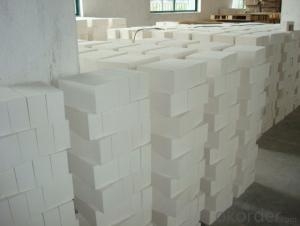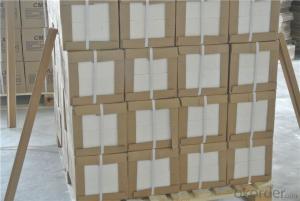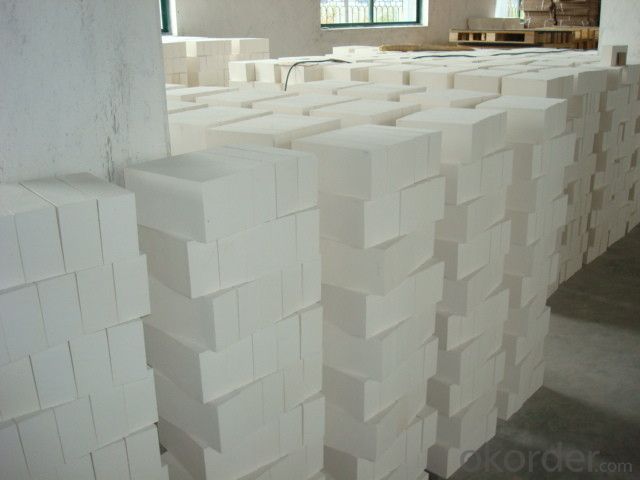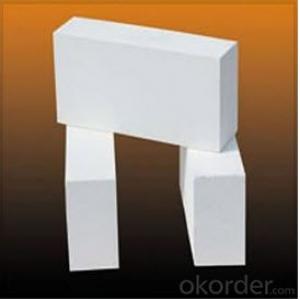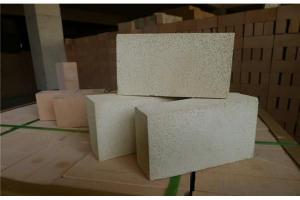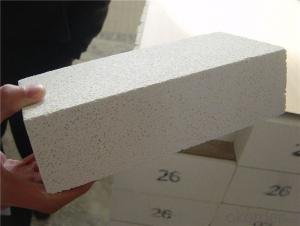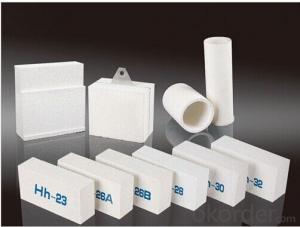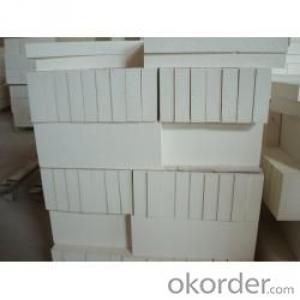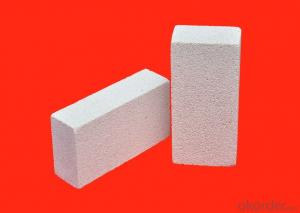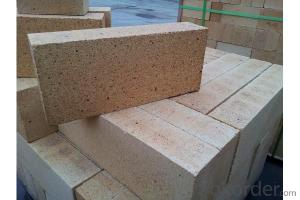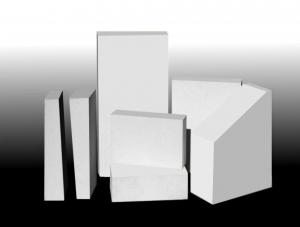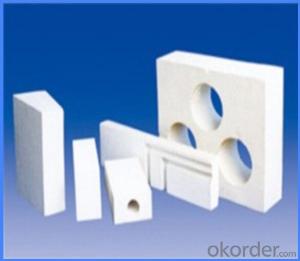Insulating Fire Brick - Mullite Insulation Brick
- Loading Port:
- Shanghai
- Payment Terms:
- TT OR LC
- Min Order Qty:
- 1 m.t.
- Supply Capability:
- 10000 m.t./month
OKorder Service Pledge
OKorder Financial Service
You Might Also Like
Thermal Insulation Fire Clay Brick
Refractory brick is a refractory material used in lining furnaces, kilns, fireboxes, and fireplaces.
We provide high quality Refractory Fire Bricks that are used on wide range in the various industries like Cement, Glass and Steel. Refractory Fire Bricks are provided as per the quantity and specifications required by the customers. We provide an extensive range of Refractory Fire Bricks at reasonable prices that depend upon the quantity ordered.
Application
Insulating Fire Brick are used for the lining of converter, alternating current arc furnace, direct Current arc furnace and the ladle slag line, etc.
Company Advantage
(1)Long Insulating Fire Brick manufacture history: 25 years manufacturer
(2)Advanced equipment and good service
(3)Diversification of production standards: ISO ANSI FEPA JIS ASTM
(4)Flexible payment: T/T L/C D/P D/A
(5)Professional marketing team and after-sale service
Insulating Fire Brick main feature:
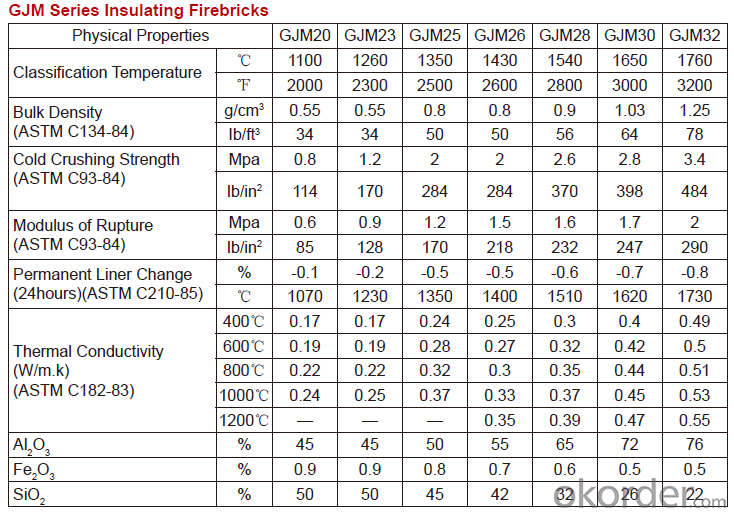
Equipment
1 unit of Ceramic Abrasive (SG Abrasive) pilot production line
2 units of Compact grain Abrasive pilot production lines
1 unit of high-end coated abrasives (abrasive cloth) production line
3 large flexible crushing and sieving lines for grit production lines
6 units of 5000KVA-10000KVA dumping type electric arc furnaces for Brown Fused Alumina fusion
FAQs
Q1 What’s the transport method?
A1 FCL delivery goods with wooden pallet or wooden case by sea; If LCL delivery, must with wooden case; Sometimes need open top, flat rack or bulk cargo.
Q2 What’s the required payment term?
A2 Generally 30% TT as the prepayment, 70% TT before delivery. If need, 100% Irrevocable Letter of Credit or negotiation.
Q3 Which country are our products exported to?
A3 Apart from entire Chinese market, the US, Russia, Japan, Korea, Australia and some Southeast Asian Nations.
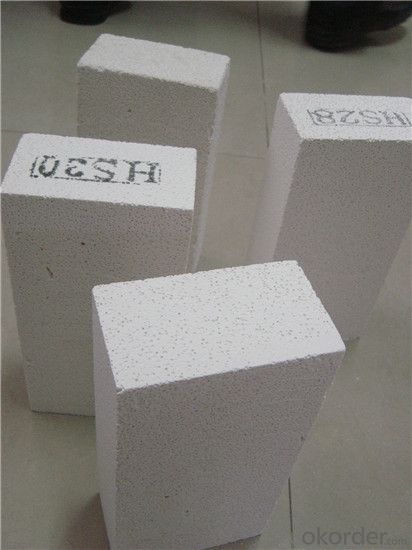

- Q: Do insulating fire bricks have a low density?
- Yes, insulating fire bricks have a low density compared to other types of bricks. These bricks are designed to have a porous structure, which helps in reducing heat transfer and increasing insulation properties. The low density of insulating fire bricks allows them to provide effective thermal insulation while also being lightweight. This makes them suitable for various applications where heat retention and energy efficiency are important, such as in kilns, furnaces, and fireplaces.
- Q: Can insulating fire bricks be used as a lining material for boilers?
- Yes, insulating fire bricks can be used as a lining material for boilers. Insulating fire bricks are made from lightweight refractory materials that have high insulating properties. These bricks are designed to withstand high temperatures, making them suitable for use in boilers where temperatures can reach up to several hundred degrees Celsius. The insulating properties of these bricks help to reduce heat loss, improving the energy efficiency of the boiler. Additionally, insulating fire bricks are resistant to thermal shock, which is crucial for withstanding the rapid temperature changes that occur in boilers. Overall, insulating fire bricks are a suitable choice for lining boilers due to their excellent insulating properties and ability to withstand high temperatures.
- Q: Can insulating fire bricks be used for insulation in cold storage facilities?
- Indeed, insulating fire bricks have the capability to be utilized for insulation purposes within cold storage facilities. These bricks are fashioned from lightweight materials possessing exceptional insulating properties, such as ceramic or refractory fibers. Their low thermal conductivity allows for the efficient prevention of heat transfer and the maintenance of a consistent temperature inside the cold storage facility. Moreover, these bricks exhibit resistance to extreme cold temperatures and possess the ability to endure thermal shock, rendering them fitting for employment in cold storage applications. Furthermore, insulating fire bricks possess durability and are capable of providing long-term insulation, thereby reducing energy consumption and preserving the desired temperature required for storing perishable goods.
- Q: Can insulating fire bricks be used in the construction of lime recovery kilns?
- Yes, insulating fire bricks can be used in the construction of lime recovery kilns. Lime recovery kilns are high-temperature industrial furnaces used to convert limestone (calcium carbonate) into lime (calcium oxide) through a process called calcination. Insulating fire bricks are designed to withstand high temperatures and provide excellent thermal insulation. They are made from lightweight refractory materials, such as clay or silica, and have low thermal conductivity. In lime recovery kilns, where temperatures can reach up to 900-1200 degrees Celsius, insulating fire bricks can be used to line the walls, floors, and roofs of the kiln. Their high insulating properties help to reduce heat loss and improve energy efficiency by keeping the heat inside the kiln. This leads to lower fuel consumption and cost savings. Furthermore, insulating fire bricks have good resistance to thermal shock, which is crucial in the lime recovery process. The kilns undergo repeated heating and cooling cycles, and the bricks must be able to withstand these temperature changes without cracking or disintegrating. Overall, insulating fire bricks are a suitable choice for lime recovery kilns due to their ability to withstand high temperatures, provide thermal insulation, and resist thermal shock.
- Q: What are insulation bricks for? Do not use high-rise buildings on the ah?
- Heat preservation bricks are of course used for insulation... Tall buildings should not be used
- Q: Can insulating fire bricks be used in the construction of refractory linings?
- Indeed, the utilization of insulating fire bricks is possible when constructing refractory linings. These bricks are explicitly engineered to possess exceptional thermal insulation characteristics, rendering them highly suitable for situations necessitating the containment of extreme temperatures. They are frequently employed in the establishment of furnaces, kilns, and other environments that experience elevated heat levels. The insulating attributes of these bricks aid in diminishing heat dissipation, enhancing energy efficiency, and upholding a consistent temperature within the refractory lining. Furthermore, insulating fire bricks are lightweight and effortless to manipulate, thereby constituting a pragmatic selection for the construction of refractory linings.
- Q: Can insulating fire bricks be used in solar power plants?
- Yes, insulating fire bricks can be used in solar power plants. Insulating fire bricks are designed to have excellent thermal insulation properties, making them suitable for applications that require heat resistance and energy efficiency. Solar power plants often involve high temperatures and the need to retain heat, such as in concentrated solar power (CSP) systems. Insulating fire bricks can be used to line the walls and floors of CSP receivers and thermal storage systems, helping to minimize heat loss and maximize the conversion of solar energy into electricity. Additionally, insulating fire bricks can also be used in other components of solar power plants, such as in the insulation of solar panels or in the construction of solar tower structures.
- Q: Can insulating fire bricks be used in thermal insulation panels?
- Yes, insulating fire bricks can be used in thermal insulation panels. Insulating fire bricks are made from lightweight materials such as clay, alumina, and silica, which have excellent thermal insulation properties. These bricks are designed to withstand high temperatures and provide insulation in various applications, including furnaces, kilns, and industrial equipment. When used in thermal insulation panels, insulating fire bricks can help reduce heat transfer and improve energy efficiency. They can effectively trap and reflect heat, preventing it from escaping or entering the insulated area. This makes them suitable for insulating walls, roofs, and other structures where thermal insulation is required. Moreover, insulating fire bricks are easy to install and can be cut or shaped to fit different spaces and configurations. This flexibility allows for customization and ensures a tight and efficient insulation barrier. It is worth noting that while insulating fire bricks provide excellent thermal insulation, they may not be as effective in sound insulation. Therefore, if soundproofing is also a requirement, additional soundproofing measures may need to be taken. Overall, insulating fire bricks are a reliable choice for thermal insulation panels, offering high insulation performance, durability, and versatility.
- Q: Are insulating fire bricks resistant to water penetration?
- Yes, insulating fire bricks are resistant to water penetration. These bricks are designed to have a low porosity and are made from materials that are not prone to absorbing or retaining water. They are typically composed of lightweight refractory materials such as alumina, silica, and other minerals that have high heat resistance and low water absorption properties. This makes insulating fire bricks ideal for applications where water penetration could be detrimental, such as in high-temperature environments or when used as insulation in chimneys or kilns. However, it is important to note that while these bricks are resistant to water penetration, they are not completely impervious to it. Prolonged exposure to water may eventually lead to some level of water absorption, which can affect their insulating properties. Therefore, it is advisable to take precautions and ensure proper installation and maintenance to maximize their resistance to water penetration.
- Q: Do insulating fire bricks have a high thermal conductivity?
- No, insulating fire bricks have a low thermal conductivity.
Send your message to us
Insulating Fire Brick - Mullite Insulation Brick
- Loading Port:
- Shanghai
- Payment Terms:
- TT OR LC
- Min Order Qty:
- 1 m.t.
- Supply Capability:
- 10000 m.t./month
OKorder Service Pledge
OKorder Financial Service
Similar products
Hot products
Hot Searches
Related keywords
